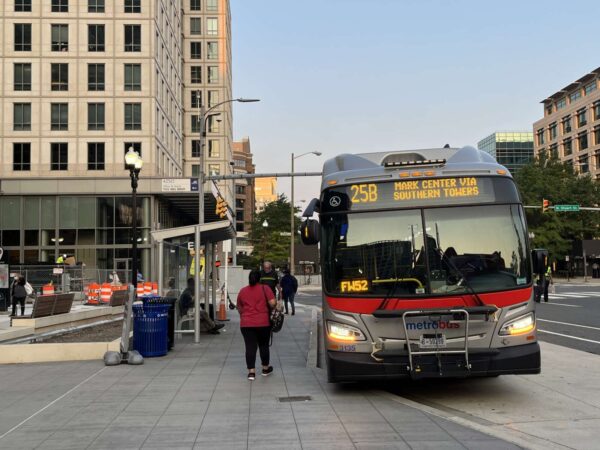
(Updated 6:00 p.m.) A new survey shows that a majority of Arlingtonians are satisfied with public transit, but their levels of satisfaction vary by geography.
Mobility Lab, a division of Arlington County Commuter Services, surveyed county residents last year to gauge travel patterns for work and non-work trips as well as concerns about public transit. This “state of the commute” survey was last conducted in 2010 and 2016, and the 2021 results included additional information about the pandemic’s effect on travel in Arlington.
ACCS uses the data to improve how it markets bicycling, walking and transit options to residents, businesses, and commercial and residential property managers, said Dept. of Environmental Services spokeswoman Claudia Pors. Those people-facing efforts include Bike Arlington, Walk Arlington and Arlington Transportation Partners.
“The primary uses of ACCS surveys are to check how well these programs are running,” she told ARLnow.
Of the 4,213 respondents, 71% of residents said they were satisfied with transit in Arlington. But people living along Metro corridors were happier with their options than people living in parts of South Arlington where the bus is the main transit mode.
People living along the Rosslyn-Ballston and Route 1 corridors were the most satisfied with their options, at 81% and 75%, respectively. And they were more likely to be members of Capital Bikeshare, at 37% and 38%, respectively.
Outside of the Metrorail corridor, the survey found satisfaction levels of 64% in Shirlington, 58% in Columbia Pike and 64% in what was deemed “Other South.” Shirlington residents reported lower rates of availability for various transportation services in general and only 13% said they had a Bikeshare membership.
Pors said a takeaway from the survey for ACCS might be that they need to focus their outreach in Shirlington “to make sure they’re aware of their options… and make sure apartment managers are talking to tenants, and using daily face time to make sure they’re fully informed.”
What the data will not do, Pors said, is set which transit projects to prioritize — for instance, applying more time and staff to improving bus transit along the Pike over adding a second entrance to the Ballston Metro station.
Concerns about safety and long waits
While generally happy with their options, Arlingtonians did have some gripes with the transit system, including how long one must wait for the bus or Metrorail as opposed to driving.
Nearly 40% said they would have to wait too long for transit to arrive while another 35% said the trip would take too long.
As for barriers to bicycling, two-thirds of residents said they don’t feel safe riding a bike in traffic, while another 37% mentioned concerns about the network of bike paths or bike lanes.
The pandemic spurs changes
The survey showed how transit use for non-work trips changed during the pandemic. While remote work contributed to the widely reported steep drop in Metro ridership, between 2015 and 2021, transit use for non-work trips also declined from 87% to 68%.
But one form of transportation increased during the pandemic: walking. About 34% reported walking “somewhat more” for non-work trips and 22% walking “much more.”
In fact, many respondents said the most important transportation needs facing the county post-pandemic are ones that take them outside: walking (58%) and cycling and scooting (42%).
Meanwhile, most respondents said they won’t be changing their commuting mode anytime soon: 81% who drove alone, 82% who used transit, and 71% who biked or walked indicated they would keep doing so post-pandemic.
Still, to chip away at those statistics, Arlington is embarking on extensive marketing efforts to encourage people to swipe their SmarTrip cards and stop driving.
“Through ACCS, [the county is] going to come out with more messaging to get people to feel comfortable on transit again,” Pors said. “There has been that loyal set of riders who’ve stayed through the pandemic. Maybe this is an opportunity for people who shifted to single-occupancy vehicles to try something new, and pitching bus as that option.”

